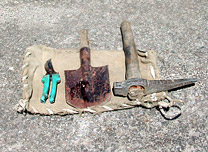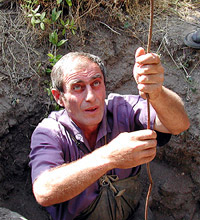The majority of people never appreciate what it has. They live their life always trying to find something else; they die knowing that the thing that they want is somewhere distant, despite the fact that they are surrounded with the things needed to acquire that.”
Chinese folktale
The “Meghri 1” benevolent NGO is implementing a project called “Restoration of the Shvanidzor village and the kyarez (water supply system)” with the grant provided by Sweden’s development and cooperation agency. The NGO is also collaborating with the international department of Migration.
The Shvanidzor village is located in Meghri, which is in the region of Syunik. It is at the far south of Armenia, just 400 kilometers away from Yerevan. It occupies 4222 hectares and has 362 residents. The village is surrounded by fields of fruit trees.
There are four kyarez (water supply systems) which are remainders of the Middle Age and they serve as the main source of water supply in the village. Kyarez is a Persian word. Getting the kyarez out by digging a pit is part of Eastern culture. The kyarez is the oldest method of getting water. Kyarez was introduced in Armenia around 721-705 b.c. Kyarez can be found in Iran, Afghanistan, India, China, etc. The residents of the southern part of the Arax valley located in the Meghri region, including the city of Meghri, the villages of Shvanidzor, Aghvank, Nonavan drink from the kyarez.
The structure of the kyarez is very simple. The first pit for getting water is not dug too deep underground; it is a narrow and deep well which reaches the water surface. The second pit is dug with an eight to ten meter distance, then the third, fourth, hundredth, until the depth of the pits reaches two meters. Then, starting from the last pit which is the beginning of the stream, all the pits are united and connected to the first.
“You can walk around, go into a territory and not know if something like that exists there. There is nothing attractive, it has no appearance but it can supply all the residents with water,” says architect and head of the “Meghri 1” organization Armine Petrosyan. She believes that the kyarez is a good method of getting water, it is not too expensive and can supply water to everyone.
The kyarez (underground water supply system) used to function, however, not very effectively. Studies showed that not one of the water supply systems had been renovated during the past 100 years. As a matter of fact, these underground structures have been severely damaged throughout the course of time due to the intervention of non-professionals. According to the villagers, even 90-year olds do not remember when the kyarez was cleaned the last time.
 The kyarez renovation project is being implemented by the only professional in Armenia Yuri Grigoryan. He is the chief kankan there. Kankan is a Persian word and it means “destroying pits”. The kankans (pit destroyer) are highly respected in the district. They don’t use complex instruments, they don’t know anything about geometry but they work with the sense of nature and location.
The kyarez renovation project is being implemented by the only professional in Armenia Yuri Grigoryan. He is the chief kankan there. Kankan is a Persian word and it means “destroying pits”. The kankans (pit destroyer) are highly respected in the district. They don’t use complex instruments, they don’t know anything about geometry but they work with the sense of nature and location.
“There is a secret lurking around everywhere here. Each linear meter has a secret. Unfortunately, I can not figure out that secret. I really don’t consider myself an expert in this field yet,” says Yuri Grigoryan who is a thirty-year expert in digging and cleaning kyarez (underground water supply systems).
He has learned this forgotten profession out of curiosity and stubbornness because as he says, kankans (pit destroyers) do not transfer any knowledge; they just inherit it to their children. By working as an assistant with the then “democrat Iranians” who had emigrated to Azerbaijan after the revolution, Yuri had managed to learn the secrets of this underground work. “They used to come up with reasons for sending me somewhere when they were connecting the pits so that I wouldn’t see how it was done,” recalls Yuri, “but then I would go down to the pits at night and watch.”
For centuries, kyarez (underground water supply systems) have been the main source of existence for man. During the past century, along with technological developments, the kyarez have lost their value, however, they have become more valuable over time because people have begun to realize that these hydraulic structures are eternal, they keep functioning without demand for expense and investments.
“Nobody knows for sure how long the kyarez have existed, but we can surely say that it is older than the residence because first there is water, then the people come to live,” says Yuri Grigoryan. He compares the kyarez with our ancient architectural structures. “We know about Armenian architecture, but what we don’t know is that there is an architecture found underground. We don’t see anything from the outside, but when you clean, dig and reach the main parts, it turns into a magnificent architectural structure which supplies water 12 months a year.”
Kyarez must be taken care of. It is necessary to clean the water supplying streams every year during the spring, follow up on the pits and underground passage periodically. The underground passage must be checked after downpours and clear anything that closes the pathway. By taking all of this into consideration, chief kankan (pit destructor) Yuri Grigoryan has taught his students and worked at the same time. He has taught them so that they can continue after him.
The residents of the Shvanidzor village are also taking part in this big project which is of great significance. Sixty seven year-old pensioner Misha Ananyan has been a wall builder back in the days. Misha has gotten rid of the cracks in the kyarez wall upon request of Yuri Grigoryan. “One day, Yuri told me that there was a crack somewhere and asked me to go and build that part of the wall. I thought to myself: this is for our village, others care for our village and I have the talent for building walls. So, I decided to go,” says Misha Ananyan.
The “Shvanidzor Water Union” NGO was founded for water users and implements projects for maintaining and taking care of the kyarez, renovating, distributing the water correctly, standardizing the ecological situation of the water and other projects for the village.
President of the NGO Hmayak Vartanyan is satisfied with the results. “We used to receive 10-15 liters of water a second when we first started. Now, we get 30-35 liters after cleaning the pit. If we don’t have any water, the people will not survive.” The NGO’s board president says that the next step is to distribute the water from the kyarez to the homes.
Let’s recall the introduction to this article: the wise man from the Chinese folktale teaches his king not to search for miracles-“Use what you have”, said the wise man. This means that we must use what we have and do the best that we can. This project, implemented by the “Meghri”1” organization and other collaborators, goes along with the same precept-to do everything it can by using the gifts of nature and man. It is then that the people will be amazed and agree that life is getting better.
www.hetq.am

